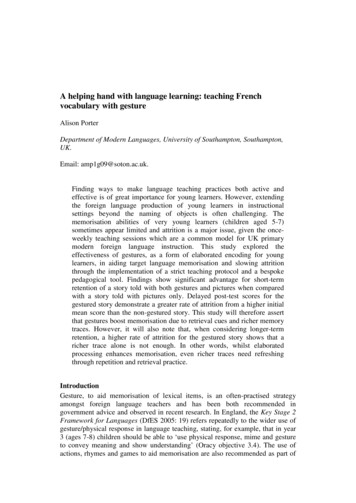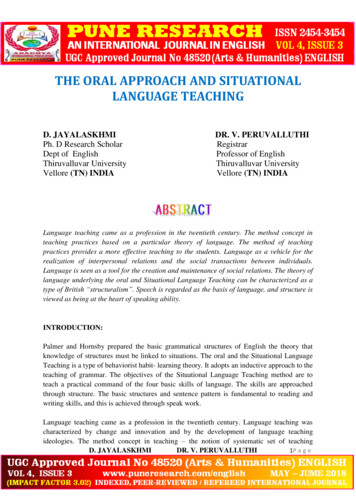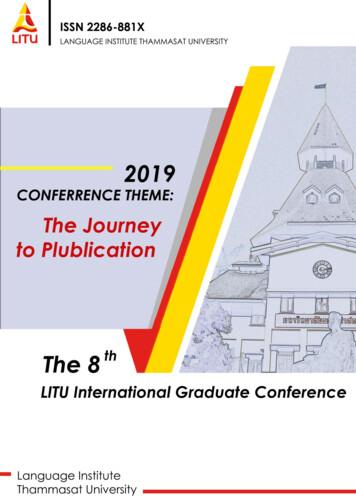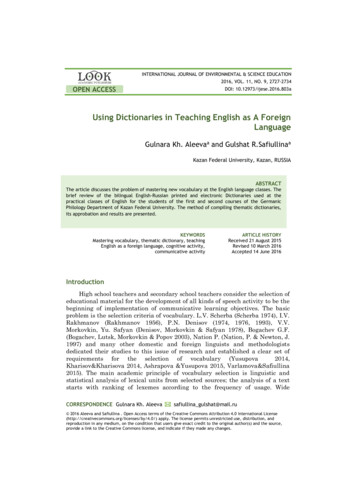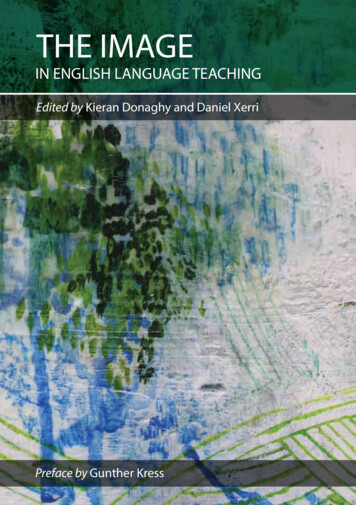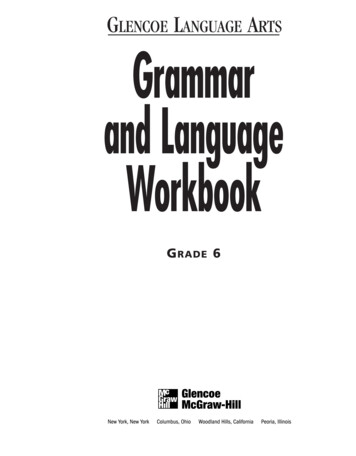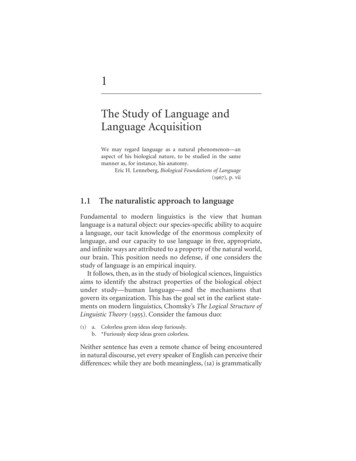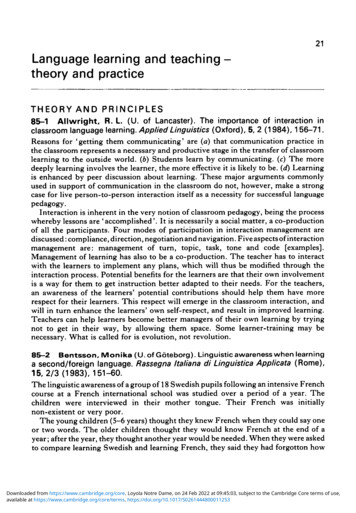
Transcription
21Language learning and teaching theory and practiceTHEORY AND PRINCIPLES85-1 Allwright, R. L. (U. of Lancaster). The importance of interaction inclassroom language learning. Applied Linguistics (Oxford), 5, 2 (1984), 156-71.Reasons for 'getting them communicating' are (a) that communication practice inthe classroom represents a necessary and productive stage in the transfer of classroomlearning to the outside world. (6) Students learn by communicating, (c) The moredeeply learning involves the learner, the more effective it is likely to be. (d) Learningis enhanced by peer discussion about learning. These major arguments commonlyused in support of communication in the classroom do not, however, make a strongcase for live person-to-person interaction itself as a necessity for successful languagepedagogy.Interaction is inherent in the very notion of classroom pedagogy, being the processwhereby lessons are 'accomplished'. It is necessarily a social matter, a co-productionof all the participants. Four modes of participation in interaction management arediscussed: compliance, direction, negotiation and navigation. Five aspectsof interactionmanagement are: management of turn, topic, task, tone and code [examples].Management of learning has also to be a co-production. The teacher has to interactwith the learners to implement any plans, which will thus be modified through theinteraction process. Potential benefits for the learners are that their own involvementis a way for them to get instruction better adapted to their needs. For the teachers,an awareness of the learners' potential contributions should help them have morerespect for their learners. This respect will emerge in the classroom interaction, andwill in turn enhance the learners' own self-respect, and result in improved learning.Teachers can help learners become better managers of their own learning by tryingnot to get in their way, by allowing them space. Some learner-training may benecessary. What is called for is evolution, not revolution.85-2 Bentsson, Monika (U.of Goteborg). Linguistic awareness when learninga second/foreign language. Rassegna Italians di Linguistica Applicata (Rome),15, 2/3(1983), 151-60.The linguistic awareness of a group of 18 Swedish pupils following an intensive Frenchcourse at a French international school was studied over a period of a year. Thechildren were interviewed in their mother tongue. Their French was initiallynon-existent or very poor.The young children (5-6 years) thought they knew French when they could say oneor two words. The older children thought they would know French at the end of ayear; after the year, they thought another year would be needed. When they were askedto compare learning Swedish and learning French, they said they had forgotton howDownloaded from https://www.cambridge.org/core. Loyola Notre Dame, on 24 Feb 2022 at 09:45:03, subject to the Cambridge Core terms of use,available at https://www.cambridge.org/core/terms. https://doi.org/10.1017/S0261444800011253
22Language learning and teachingthey learned their first language. They appreciated that learning a second languagewas different from learning a foreign language. When asked 'What is grammar?' theyoung children said that grammar existed in French but not in Swedish (meaning theyhad a lesson called 'grammaire' in French but not in Swedish). They later said thatgrammar is when you write with a red pencil, later still that grammar was verb endings.The older children thought that grammar primarily concerned writing, rather thanspeaking. The children thought that people became linguistically aware when theybegan learning a new language.85-3 Brumfit, Christopher (U. of London Inst. of Ed.). Some problems withKrashen's concepts, 'acquisition' and ' Learning'. Nottingham Linguistic Circular(Nottingham), 12, 2 (1983), 95-105.Krashen asserts that there is no connection between acts of conscious learning andunconscious acquisition. The implication is that formal teaching may actually preventeffective language acquisition. Widdowson distinguishes more helpfully between'expression rules' (rules which govern what the learner does with language) and'reference rules' (which characterise the learner's knowledge). This helps to explainhow the two systems can co-exist in the same learner.The distinction between explicit and implicit knowledge on which the learning/acquisition distinction is based, poses major methodological problems. WhileKrashen's Monitor Model appears attractive, it raises questions which create logicalnonsense. Unless there is some connection between acquisition and learning, manyinformed and skilled learners have wasted a great deal of time. Krashen has made atleast two unjustified confusions: (1) he identifies conscious learning with the consciouslearning of rules of grammar and (2) he identifies the process of monitoring with thecareful, conscious application of rules. This is like saying you cannot use a languageif you cannot produce automatic appropriate responses.85-4 Oksaar. Els (U. of Hamburg). Language learning as cultural learning.Rassegna Italians di Linguistica Applicata (Rome), 15, 2/3 (1983), 121-30.Cultural learning is a necessary aspect of learning a language. Three longitudinalprojects are being carried out at Hamburg on (1) bilingual verbal behaviour, (2) thelanguage acquisition of children raised mono-, bi-, tri- and quadrilingually, and (3)identity studies of minorities. The approach is integrative, i.e. does not isolatelanguage from non-verbal means of expression. Sociocultural behaviour patterns canbe systematised by the author's 'cultureme' model. This operates on the assumptionthat communicative behaviour patterns can be isolated. Culturemes may be realiseddifferently in different communicative acts, either verbally, non-verbally, extraverbally,or all three. The linguistic level is closely bound to the cultural level.Downloaded from https://www.cambridge.org/core. Loyola Notre Dame, on 24 Feb 2022 at 09:45:03, subject to the Cambridge Core terms of use,available at https://www.cambridge.org/core/terms. https://doi.org/10.1017/S0261444800011253
Theory and principles2385-5 Roulet. Eddy (U. of Geneva). Ou en est-on dans le d veloppement d'uneapproche int gre e des pedagogies de L1 et de L2? [How far have we progressedtowards an integrated approach to teaching L1 and L2?] Bulletin of the CAAL(Montreal), 5, 2 (1983), 95-115.From the debate and discussion [summarised here] during the decade following theFourth ACLA conference in 1973 (which called for the teaching of the mother tongueand of modern languages to be based on common linguistic principles), a consensushas emerged in favour of an integrated approach to language teaching; there is generalacceptance that the time has come to abandon theoretical arguments in favour ofempiral research into learners' problems.Many teachers are ill equipped to utilise a communicative approach. There is a needto develop the learners' awareness of, and capacity for reflecting on, the nature oflanguage. Thinking about language is not incompatible with communication. It mustalso be recognised that learners needs and situations and learning strategies may differconsiderably and they necessarily influence both the degree of integration and itsnature.85-6 Ruckert, Gerd. Zur Funktion von Verfahrenskenntnissen imFremdsprachenunterricht. [The role of learning skills in foreign language learning].Fremdsprachenunterricht (Berlin, GDR), 27, 6 (1983), 288-91.Learning skills in foreign language learning fall into three main areas: (1) certainrelatively limited and controlled language learning activities, (2) complex targetactivities, (3) other activities, which though not language activities in themselves, maybe combined with the target activities. Language-learning activities are defined hereas those activities used for the acquisition of language matter and the developmentof language skills. They further act as a vital basis for target activities. Target activitiesand the non-linguistic activities which may be combined with them (e.g. note-takingon the basis of a spoken text) are relevant to real communicative situations outsidethe classroom. Within the classroom context, however, in addition to the theirreflecting real communication, they also have learning functions. Learning skills mustbe acquired alongside the language itself, and their acquisition must be an organic andintegral part of the language course and the language-learning process. However, theselearning skills must be graded and appropriate ones learnt at appropriate stages of thecourse. Language-learning activities are appropriate for beginners. As studentsprogress, the target activities become more relevant, and with them the othernon-linguistic activities.A course in the development of reading skills, discussed here, shows how theacquisition of learning skills can be an integral part of the course.Downloaded from https://www.cambridge.org/core. Loyola Notre Dame, on 24 Feb 2022 at 09:45:03, subject to the Cambridge Core terms of use,available at https://www.cambridge.org/core/terms. https://doi.org/10.1017/S0261444800011253
24Language learning and teaching85-7 Schwerdtfeger, Inge C. (Ruhr-U. Bochum). Foreigner talk: implicationsfor foreign language teaching? Nottingham Linguistic Circular (Nottingham), 12,2 (1983), 141-58.' Foreigner talk' (FT) here refers to the interaction strategies of native speakers incommunication with foreigners. There is no implication of' talking down'. A synopsiswas made of available studies of F T which revealed various regularities (somedisputed). Researchers should be careful to avoid identifying idiosyncrasies in a nativespeaker's speech as F T ; even small children use F T ; F T does not necessarily entaila reduction in speech tempo, but the native speaker uses a limited vocabulary, conveysfewer propositions, and uses fewer idioms and set phrases. F T utterances are shortand syntactically less complex but are within the norms of the target language; fewrefer to phenomena of the immediate surroundings. Native speakers need a signal fromthe foreigner that he understands the FT utterance before continuing with anexplanation. Instead of simplifying syntactic structures, native speakers repair complexquestions in order to reduce the choice of answers for the non-native speaker. Theyalso use self-repetition if the foreigner is unclear about an utterance. Native speakersfeel more at ease in proportion to the foreigner's ability to communicate. Theresponsibility for keeping the conversation going lies with the native speaker.A revaluation of FT research results is proposed under a functional heading whichconcentrates on communicative achievements and intentions of native speakers,despite the fact that no agreement has been reached in defining functional categories.[An extract from a study of F T in progress is discussed in detail.]Teachers in training should benefit from an understanding of basic strategies of FT.Greater emphasis should be put on teaching turn-taking strategies and conversationalrhythm from the beginning. Teaching materials should include life-like dialogueswherein both speakers use normal conversational strategies [examples].85-8 Tucker, G. Richard. Toward the development of a language-competentAmerican society. International Journal of the Sociology of Language (Amsterdam), 45 (1984), 153-60.All residents of the United States should have an opportunity to develop a high degreeof proficiency in understanding, speaking, reading and writing English, whether it istheir mother tongue or a second language, while non-native speakers should have anopportunity to develop proficiency in their mother tongue. There are more bilingualsthan monolinguals in the world today, and many more children are educated in asecond language than exclusively via their mother tongue. No universal policy can beformulated with respect to the choice and sequencing of languages for instructionalpurposes, but planners must consider factors such as the roles and status of languagesin contact in any particular region, community attitudes to languages, whether anaccepted orthography and literary tradition for the target language(s) exist, likewisea sufficient body of materials written in the target language(s), the availability oftrained teachers, etc.Innovative instructional programmes should be designed to encourage the development of second-language skills for as broad a spectrum of school-age children asDownloaded from https://www.cambridge.org/core. Loyola Notre Dame, on 24 Feb 2022 at 09:45:03, subject to the Cambridge Core terms of use,available at https://www.cambridge.org/core/terms. https://doi.org/10.1017/S0261444800011253
Theory and principles25possible. The needs of at least four distinct groups should be considered: (1)non-English proficient/limited-English proficient (NEP/LEP) individuals; (2) balanced bilinguals; (3) English-dominant linguistic-minority individuals; (4) nativeEnglish monolingual individuals (Anglo-Americans and those of other ethnic/nativeorigins). Each category needs different educational options to be designed and madeavailable for them.Most American federally funded programmes have focused on the needs ofNEP/LEP students; their goal is transitional, i.e. to utilise the student's homelanguage as a bridge to facilitate the rapid acquisition of English and are based on acompensatory education model which is discouraging to majority-language groupparticipation. In a maintenance programme, still the subject of controversy, studentsare encouraged to develop all skills in both languages across all domains. A third optionis the restoration model, which aims to develop 'lost' skills in the home or ancestrallanguage. Popular support for such programmes seems to be growing. A fourth typeis an enrichment model, which aims to capitalise on the demonstrated intellectualbenefits of bilingualism, particularly for English-majority monolinguals.85-9 Weinrich. Harald. Sprachmischung und Fremdsprachendidaktik. [Language mixing and the teaching of foreing languages.] Der fremdsprachlicheUnterricht (Stuttgart, FRG), 67 (1983), 207-14.Observations made on bilingual language acquisition, particularly among children,show that elements of the two languages in question tend to be mixed by the learnersat certain stages of the acquisition process. One of the languages usually determinesthe structural patterns used while the other contributes lexical matter only. Similarphenomena occur where a particular language group has to live in a linguisticenvironment where another language is dominant and finds itself gradually forgettingits own language, or at least losing its certainty in language awareness. Where languagestandardisation is concerned, and with it such ideals as language purity and theelimination of borrowing from other languages, any occurrences of language mixingare seen in a negative light, regardless of whether they arise from bilingualism or someother cause. In foreign language teaching, therefore, nobody has ever seriouslyconsidered the possibility that guided and supervised language mixing might be ofsome value. There have been a few very successful unofficial experiments withlanguage mixing in language courses, which should encourage official languageresearch centres to undertake basic research into the matter.P S Y C H O L O G Y OF L A N G U A G E L E A R N I N G85-10 Carrell, Patricia L. (Southern Illinois U. at Carbondale). Inferencing inESL: Presuppositions and implications of factive and implicative predicates.Language Learning (Ann Arbor, Mich) 34, 1 (1984), 1-21.One aspect of pragmatic competence in a second language is the ability to draw correctinferences. Much of the information conveyed by a text, or even a single sentence,Downloaded from https://www.cambridge.org/core. Loyola Notre Dame, on 24 Feb 2022 at 09:45:03, subject to the Cambridge Core terms of use,available at https://www.cambridge.org/core/terms. https://doi.org/10.1017/S0261444800011253
26Language learning and teachingis not conveyed directly as the literal meaning of that text or sentence, but is ratherconveyed only indirectly, as inferences which are to be drawn from the text orsentence. The process of comprehending a text or sentence, then, is at least partiallythe process of drawing correct inferences. If second language learners are to be saidto have comprehended a text or sentence, they must also have drawn the correctinferences from it. The study reported in this paper, which included both advancedand high-intermediate ESL learners as well as a control group of native speakers,investigated the drawing of two types of inferences in ESL—presuppositions andimplications—from English sentences containing factive and implicative predicates(Kiparsky & Kiparsky, 1970; Karttunen, 1971).Results of the study, which are compared to earlier empirical studies of fullyproficient native speakers of English (Just & Clark, 1973; Vosniadou, 1982), show theESL learners are in the process of acquiring this aspect of pragmatic ability in English.Specific results reveal better comprehension of implied meaning over presupposedmeaning, better performance on semantically positive predicates than on semanticallynegative predicates, and an interaction between inference type (implication versuspresupposition) and predicate polarity (positive versus negative). These results areexplained in terms of previous research on the distinction between given and newinformation. Additional research is proposed and potential pedagogical implicationsare also discussed.85-11 De Keyser, Robert M. (Stanford U.) The role of field independence inforeign language instruction. ITL (Louvain), 63 (1984), 1-21.Field independence tests assess the subject's ability to separate an item from anembedding context (e.g. to pick out a simple figure from a complex drawing). Fieldindependent people, who score high on these tests, tend to be interested in the abstractor theoretical, whereas field dependent people, who score relatively low, are lessinterested in the abstract and are more oriented towards other people [some researchfindings are reviewed]. Educational implications are that field independent subjectsare more likely to use mediating structural rules of their own design in dealing witha learning task (hypothesis testing approach), whereas field dependent subjects aremore likely to rely on characteristics of the learning task itself (spectator approach).Field independent teachers are more likely to direct the situation and providecorrective feedback. Field dependent teachers are willing to share the responsibilityof directing teaching; they are more inclined to teach facts than to encourage theirstudents to apply principles. A contrast in styles between teacher and students maywell be more stimulating than similarity.Five hypotheses concerning differences in foreign language learning strategiesbetween field dependent and field independent students under different teachingmethods are discussed: (1) field dependent students may benefit more from anaudiolingual approach and field independent learners from an inductive, grammarorientated method (though either group might well benefit from the oppositeapproach). (2) The positive cognitive effect of the audiolingual method for the fielddependent student might be counter-balanced by the impersonal characteristics of alaboratory setting. (3) Field dependent students are more sensitive to salient cues andDownloaded from https://www.cambridge.org/core. Loyola Notre Dame, on 24 Feb 2022 at 09:45:03, subject to the Cambridge Core terms of use,available at https://www.cambridge.org/core/terms. https://doi.org/10.1017/S0261444800011253
Psychology of language learning27may therefore have more problems with interference from their native language; theuse of the direct method may be more helpful than translation exercises in this respect.(4) If it could be shown that the preferred mode of LI acquisition corresponded toan individual's position on the field independence dimension, tests of field independence could be useful in determining the L2 learner's aptitude for a particularlearning method. (5) The effects of match or mismatch between teacher's andstudents' cognitive styles is particularly important in language teaching wherepupil—teacher interaction plays a major part.Research studies on field independence and language teaching are reviewed: theirfindings tend to be inconsistent, probably because of the different measures, tests, andpopulations sampled. It does, however, seem likely that there is an interaction betweenindividual information-processing modes and foreign language teaching methods.85-12 Faerch, Claus (U. of Copenhagen) and Kasper, Gabriele (U. ofAarhus). Two ways of defining communication strategies. Language Learning(Ann Arbor, Mich), 34, 1 (1984), 45-63.Two recently formulated definitions of communication strategies are contrasted.According to Tarone's 'interactional' definition, the central function of communication strategies is the negotiation of meaning. According to the ' psycholinguistic'definition suggested by Faerch and Kasper, communication strategies are related toindividual language users' experience of communicative problems and the solutions(co-operative or noncooperative) they pursue. Within the latter framework, communication strategies are characterised in discourse terms, invoking the notion of'conditional relevance'. Interactionally defined communication strategies constitutea subset of psycholinguistically defined strategies, and although this subset in manyrespects represents an important area of strategy use, significant similarities to othertypes of strategy use are obscured by defining communication strategies in interactionalterms exclusively.85-13 Gardner, R. C. (U. of Western Ontario). Learning another language. Atrue social psychological experiment. Journal of Language and Social Psychology(Clevedon, Avon), 2, 2 (1983), 219-39.Some reasons are outlined why the investigation of second language acquisition isimportant, and a socio-educational model is presented which aims to incorporate themajor individual difference variables underlying the language learning process.Research relevant to this model is presented, with particular attention devoted to adirect test of the underlying causal model. Three deductions deriving from the modelare examined. On the basis of the empirical evidence, it seems clear that attitudes andmotivation are important because they promote active involvement in the learningprocess and that they influence active choice behaviour regarding participation inacquisition contexts. There was no evidence for the deduction that differential successin second language acquisition promotes differential attitude change.Four directions for future research are discussed. These include the suggestion thatfurther attention should be directed towards using causal modelling procedures toDownloaded from https://www.cambridge.org/core. Loyola Notre Dame, on 24 Feb 2022 at 09:45:03, subject to the Cambridge Core terms of use,available at https://www.cambridge.org/core/terms. https://doi.org/10.1017/S0261444800011253
28Language learning and teachingenhance our understanding of the processes underlying second language acquisition,and the necessity for developing laboratory investigations to provide further ' causal'tests. A third direction which seems important is to extend the general correlationparadigm to other contexts. However, such extensions should use indices with knownreliability and validity, and should consider the ethnolinguistic vitality of the region.The fourth direction concerns the role of attitudes and motivation in the loss of secondlanguage skills following the termination of instruction. This is a previously unexploredarea which could have important implications for language training.85-14 Hulstijn, Jan H. (Free U., Amsterdam) and Hulstijn, Wouter (Nijmegen U.) Grammatical errors as a function of processing constraints and explicitknowledge. Language Learning (Ann Arbor, Mich), 34, 1 (1984), 23-43.The first question of this study deals with the influence of the factors Time Pressure(present or absent) and Focus of Attention (on information or on grammar) on thecorrect use of two Dutch word-order rules in the speech of 32 adult learners of thatlanguage. In an experimental repeated measures design using a story retelling task,Attention had a significant effect, but Time did not. The second question deals withthe relation between explicitness of rule knowledge, assessed in an interview, and ruleapplication, elicited in the experiment. Although the learners without explicitknowledge of the two word-order rules made more errors in the story retelling tas'kthan learners with explicit knowledge, they were influenced by Time and Attentionto the same extent as the learners with explicit knowledge.The results of this study are discussed in terms of Krashen's Monitor Theory andin terms of an information-processing approach that distinguishes executive controlfrom metacognitive knowledge.85-15 Kirby, John P. (UFSIA, Antwerp). Error analysis and interlanguagestudies: an overview. ITL (Louvain), 63 (1984), 65-80.Invoked to correct the contrastive explanation of error in the early '70s, error analysisproposed that a learner's errors represented a systematic interim competence dubbed'interlanguage', but recent research reaffirms the role of the mother tongue in alearner's developing competence, while liberating it from the habit-formation theoryof the behaviourists. The mother tongue seems to be used consciously as a prop and thelearner is aware of what can be transferred and what cannot. It does not merely'interfere'.The main terms of the interlanguage argument are reviewed critically, and researchin conflict with it is quoted to sketch the current position. There is still little consensuson the cause of learner error, but it is clearly more complex than either the contrastiveor interlanguage positions assumed; and Krashen's Monitor model, though open tocriticism, comes nearest to explaining the data collected so far.Downloaded from https://www.cambridge.org/core. Loyola Notre Dame, on 24 Feb 2022 at 09:45:03, subject to the Cambridge Core terms of use,available at https://www.cambridge.org/core/terms. https://doi.org/10.1017/S0261444800011253
Psychology of language learning2985-16 Long, Michael H. (U. of Hawaii at Manoa). Linguistic and conversational adjustments to non-native spearkers. Studies in Second Language Acquisition (Bloomington, Ind), 5, 2 (1983), 177-93.At least 40 studies have been conducted of the linguistic and conversational adjustmentsmade by native speakers of a language using it for communication with non-nativespeakers. The modifications sometimes result in ungrammatical speech. Generally,however, they serve to provide input that is well formed, a sort of linguistic andconversational cocoon for the neophyte second language acquirer. Most of the findingshold across age groups, social classes and settings, although some differences, bothqualitative and quantitative, have been noted in these areas, too.In making the adjustments described, native speakers appear to be reacting not toone, but to a combination of factors. These include the linguistic characteristics andcomprehensibility of the non-native's interlanguage, but particularly his or herapparent comprehension of what the native speaker is saying. The adjustments appearto be necessary for second language acquisition, in that beginners seem unable toacquire from unmodified native speaker input. They may even be sufficient toguarantee that acquisition occurs, though there is some doubt about this.85-17 Mackey, William F. (U. Laval, Quebec). Six questions sur la valeurd'une dichotomie (L1/L2). [Six questions concerning the L1/L2 dichotomy.]Rassegna Italiana di Linguistica Applicata (Rome), 15, 2/3 (1983), 23-58.Much research has been published on the relationship between the first and the secondlanguage (LI and L2) but the conclusions drawn in the majority of cases are merelygeneralisations from particular cases. Careful examination of the how, why, when andwhere of language acquisition is needed. Concepts such as the critical age for languagelearning, whether or not linguistic competence is innate and what it actually consistsof, and compound v. co-ordinate bilingualism, require further elucidation. LI and L2are linguists' abstractions; a closer look at the languages concerned in each case isneeded.What the infant acquires is language; later it learns to differentiate betweenlanguages. There is no simple dichtomy between LI and L2, rather a set ofmulti-dimensional relationships. Instead of two rival codes or two juxtaposed sets oflinguistic structures, we should think in terms of two sets of available symbols to beutilised for different ends at different times.85-18 Magnan, Sally Sieloff (U. of Wisconsin-Madison). Age and sensitivityto gender in French. Studies in Second Language Acquisition (Bloomington, Ind),5,2 (1983), 194 212.This study presents research on the affective reactions of native French speakers to15 types of grammatical error made by an American speaking French. The nativeFrench judges are divided into three age groups, CES students, lycee students, andadults, and an error hierarchy is provided for each. Results show a continuum by ageas to how these judges react to gender errors, that is errors of non-agreement withdefinite articles and adjectives with nouns. The younger, CES students are mostDownloaded from https://www.cambridge.org/core. Loyola Notre Dame, on 24 Feb 2022 at 09:45:03, subject to the Cambridge Core terms of use,available at https://www.cambridge.org/core/terms. https://doi.org/10.1017/S0261444800011253
30Language learning and teachingsensitive to gender
The young children (5-6 years) thought they knew French when they could say one or two words. The older children thought they would know French at the end of a year; after the year, they thought another year would be needed. When they were asked to compare learning Swedish and l

